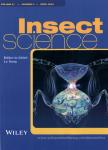Self-/conspecific discrimination and superparasitism strategy in the ovicidal parasitoid Echthrodelphax fairchildii (Hymenoptera: Dryinidae)
Self-/conspecific discrimination and superparasitism strategy in the ovicidal parasitoid Echthrodelphax fairchildii (Hymenoptera: Dryinidae)作者机构:Insect Ecology Laboratory Graduate School of Bioresources Mie University Tsu Mie Japan
出 版 物:《Insect Science》 (昆虫科学(英文版))
年 卷 期:2014年第21卷第6期
页 面:741-749页
核心收录:
学科分类:0710[理学-生物学] 07[理学] 09[农学] 0904[农学-植物保护]
主 题:infanticide ovicide plant hopper self-recognition sex ratio
摘 要:Superparasitism in solitary parasitoids results in fatal competition between the immature parasitoids, and consequently only one individual can emerge. In the semisoli- tary ovicidal parasitoid Echthrodelphaxfairchildii (Hymenoptera: Dryinidae), 2 adults can emerge under superparasitism with a short interval (〈24 h) between the first and second ovipositions. We determined the female parasitoid's behavioral responses under self- and conspecific superparasitism bouts with first-to-second oviposition intervals of 〈2 h. The self- and conspecific superparasitizing frequencies increased up to an oviposition interval of 0.75 h, with the former remaining lower than the latter, particularly for oviposition intervals of _〈0.25 h, suggesting the existence of self-/conspecific discrimination. The superparasitizing frequency plateaued for oviposition intervals of _〉0.75 h, with no dif- ference between self- and conspecific superparasitism. The ovicidal-probing frequency did not differ under self- and conspecific superparasitism, and was usually 〈20%. The females exhibited no preference for the oviposition side (i.e., ovipositing on the side with or without the first progeny) and almost always laid female eggs for any oviposition in- terval under self- and conspecific superparasitism. The sex ratio was not affected by the type of superparasitism, oviposition sides, or the occurrence of ovicidal probing. These observed results about the oviposition side, ovicidal probing, and sex ratios differed from the predictions obtained assuming that the females behave optimally. Possible reasons for the discrepancies are discussed: likely candidates include the high cost of selecting oviposition sides and ovicidal probing, and, for the sex ratio, the low frequency of encountering suitable hosts before superparasitism bouts.



